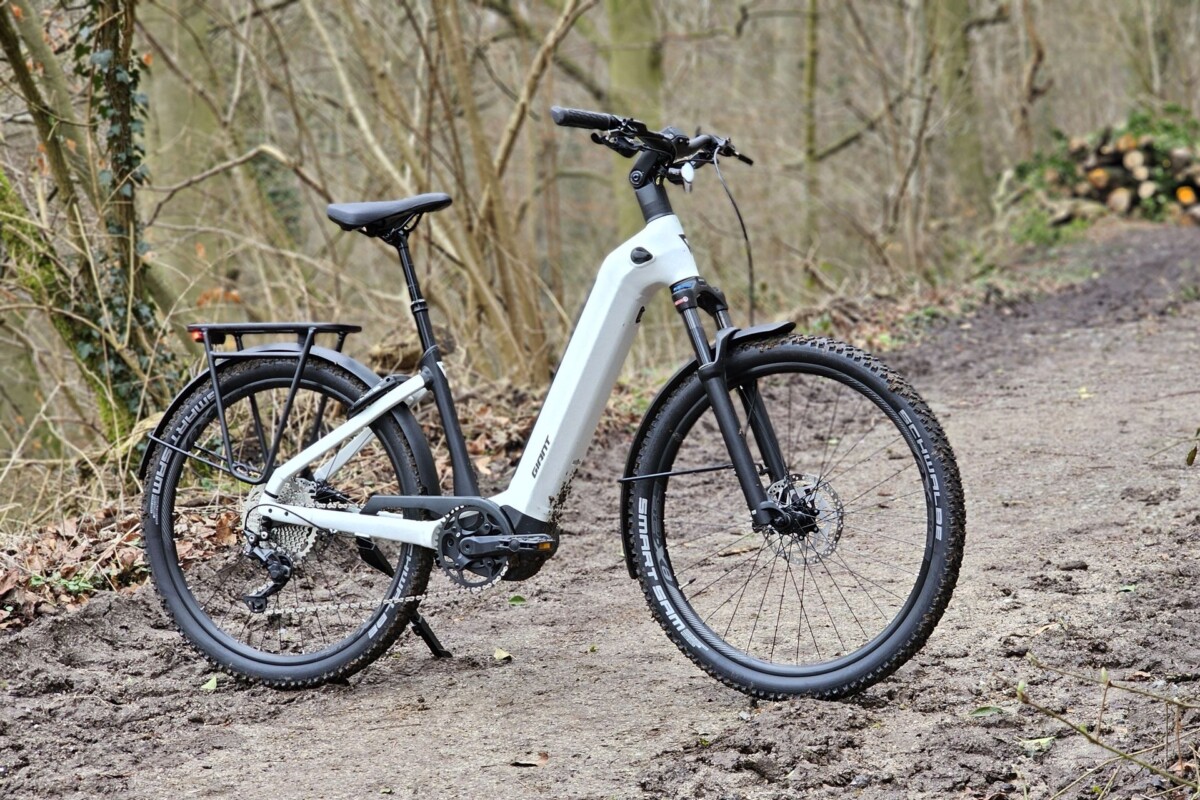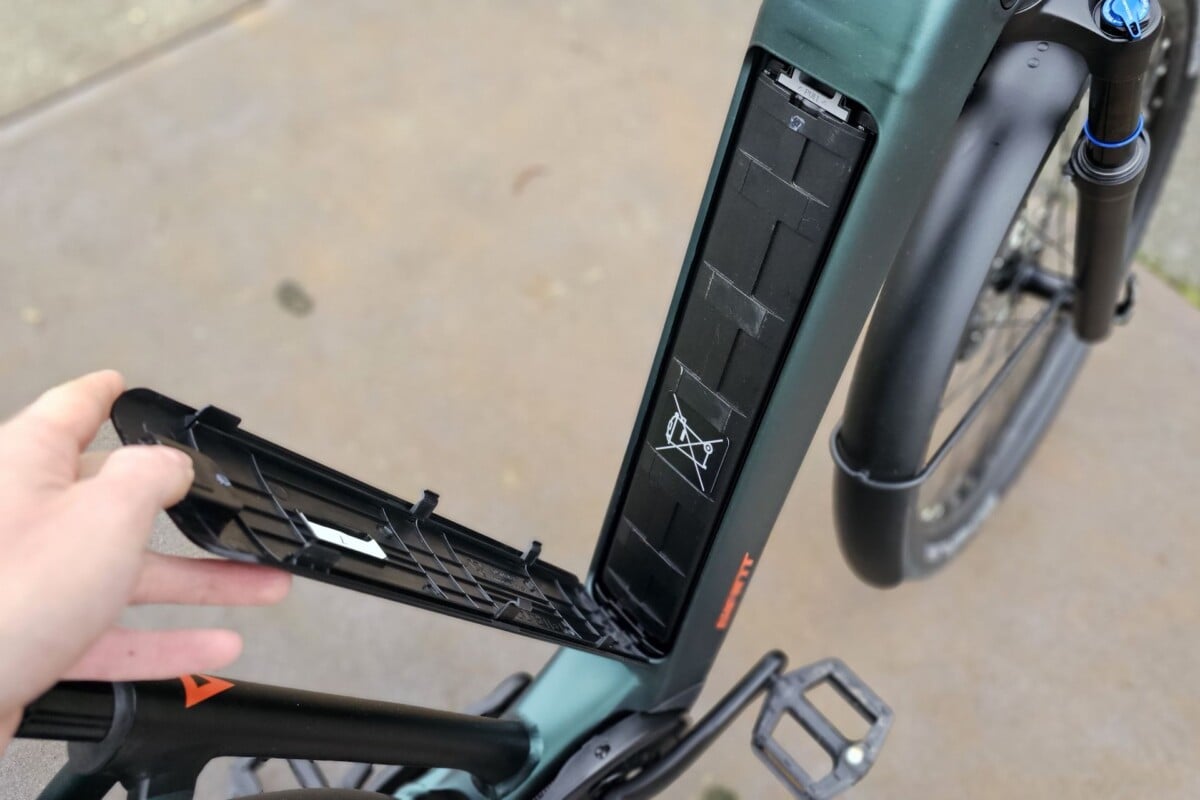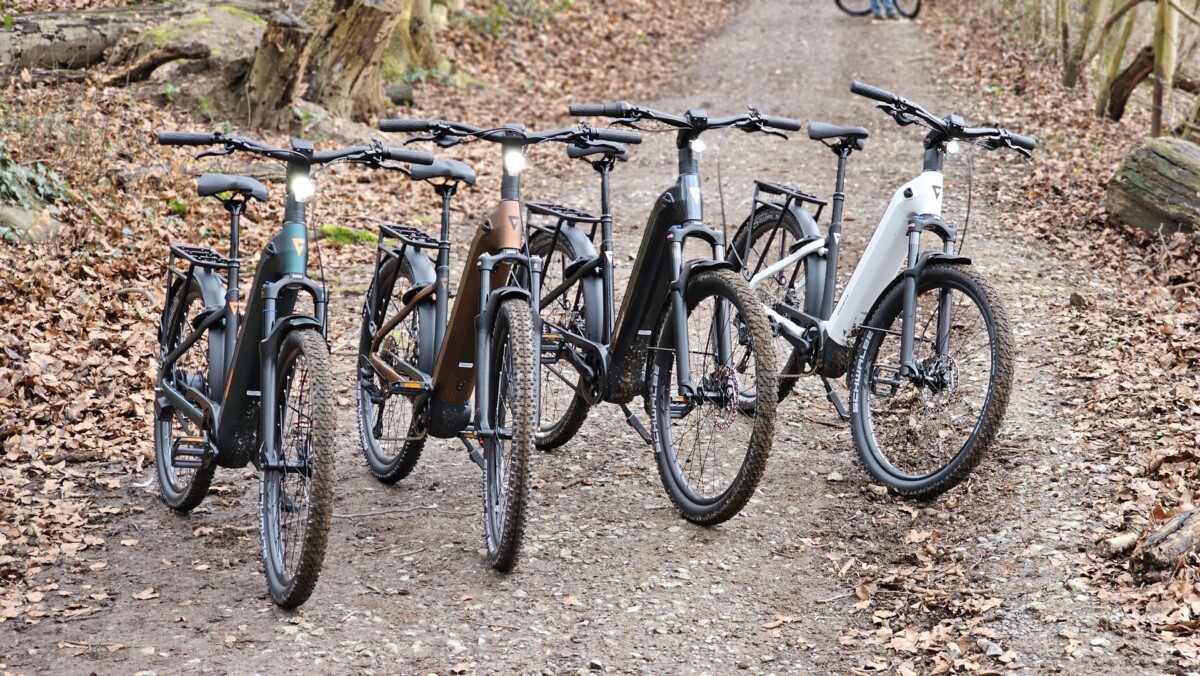Almost all-terrain thanks to its wheels and suspensions, versatile thanks to its open frame and its auto mode, the new Giant Anytour X E+ wants to go everywhere without neglecting performance. We were able to try it in Germany, here are our first impressions.
Giant may be the number 1 bicycle manufacturer in the world, but it is not the most popular in people’s minds. In any case in France, perhaps the fault is a range very focused on leisure, which stops at VTC. Precisely, this category is one of the most dynamic in the electric bike, to the point that the Taiwanese firm is introducing a new model. With 142 references – not all of them are imported – it is not close to one. We discovered the Giant Anytour X E+ in Germany, in the Düsseldorf region.
An electric VTC more trekking than urban
To understand the Anytour X E+, you have to analyze its name. Already, the E+ means that it is an electric bike, common to all models of its kind from Giant. In VTCs, the entry-level model is called Dailytour E+, a basic VTC whose battery is placed at the rear, more urban than adventurous. For its part, the most all-terrain is the Explorer E+, whose name evokes adventure. The brand also considers this model as a springboard towards trekking bikes, with the Stormguard E+ SUV, which in turn opens the way to the Stance, Talon, Fathom EX and Trance X E+ e-MTBs.

In summary, although the Giant Anytour E+ already attempted a breakthrough a few years ago, its return marks the launch of a new generation, with a new X version. The latter is seen by its creators as a trekking bike, thanks to its improved off-road capabilities. Note that only the Giant Anytour X model is available in France, and in two versions out of the four existing internationally.
The Giant Anytour X E+ focuses on the equipment and the low frame
The big surprise of the Anytour X E+ is its unique open frame, an unusual design for an electric bike intended for off-road use. This choice responds to strong demand from customers, attracted by this more inclusive design, which also makes it possible to avoid the design of several distinct models. The main difference between the base model E+ and the X E+ is the tires, which are more suitable for various types of terrain.

Giant, which masters the production of many components, manufactures its own frames. These can support up to 156kg thanks to the use of a four-metal alloy, although some frames can theoretically support up to 180kg, a load that 27.5in wheels cannot support . The bike, with its integrated wiring, displays a pleasant design, without disrupting the market. However, we note the attention paid to the front lighting, which can be installed on the handlebars or the fork, and the standard M10 compatibility with trailers.
Two versions of the Giant Anytour X, but XXL batteries
Giant, wishing to maintain control over all of its components, integrated its own Syncdrive motor, developed in collaboration with Yamaha. This motor, both compact and light (2.7 kg), is available in two versions offering 75 and 85 Nm of torque respectively. Unlike the Yamaha engines, Giant has added a modern screen, the RideDash Evo, located in the center of the handlebars, which even allows navigation using a dedicated application, Ridecontrol.

In the large diagonal beam, the electric VTC houses a battery co-signed with Panasonic. With a capacity of 625 to 800 Wh depending on the version, it announces an exceptional lifespan of 2,300 cycles (for 50% remaining capacity).
Among the four versions available, we had the opportunity to try the E+1 and E+3, which are equipped with Shimano derailleurs (Deore for the E+1 and XT Linkglide for the E+3). It is regrettable that we were unable to test the E+2, equipped with a Nexus hub and belt, which represented an attractive option, while the high-end E+0 model, equipped with a Enviolo Automatiq dimmer, turns out to be very expensive.

The Deore XT Linkglide 11 for the E+1. // Source: M. Lauraux for Frandroid

A Shimano Deore 10-speed derailleur on the Anytour X E+3. // Source: M. Lauraux for Frandroid

Push and handle controls. // Source: M. Lauraux for Frandroid
A giant SyncDrive motor player
However, this did not deter us from exploring all options, driven by our curiosity. The Enviolo system offers great versatility, but does not necessarily appeal to sporty cyclists. Although acceleration is fast, as if you had a Launch Control system, pedaling downhill becomes laborious, and gear adjustment is not as immediate as with a higher quality derailleur. Like the Nexus, it targets a wider audience, looking for simplicity, or those who plan to use their electric bike also in urban areas.

Let’s return to the Giant Anytour X E+ models equipped with derailleurs. The E+1 stands out with its 85 Nm SyncDrive Pro motor and 800 Wh battery. Although the range could only be assessed on a short drive in the German countryside, the difference in torque is noticeable, even if minimal. Acceleration is noticeably sharper on the E+1, but both models benefit from appreciable startup responsiveness, without however matching that of a Bosch Performance Line or CX, their main competitors.
Very good off-road capabilities
The behavior of these electric VTCs is very healthy, oriented towards trekking practice, which makes them less comfortable for urban use. The Anytour
However, the Suntour Mobie 25 front fork, based on a spring system, quickly reaches its limits, unlike the hydraulic XCR 32 (offering 100 mm of travel), without compromising safety. Our German colleagues, having tested the Anytour E+ equipped with thinner tires, found themselves significantly less comfortable.

Source: M. Lauraux for Frandroid

Source: M. Lauraux for Frandroid

Source: M. Lauraux for Frandroid

Source: M. Lauraux for Frandroid
The wide handlebars are particularly useful when descending on rocky paths, and the ergonomic handles are a real plus for hand comfort over long distances. However, Giant has not included a suspension or telescopic saddle in the equipment. It nevertheless remains complete, with good mudguards (effectiveness tested, our shoes are grateful), a MIK HD rear luggage rack, a kickstand and headlights linked to the battery.
A very nice screen, while waiting to try the app
The screen is nice and colorful, but it is prone to reflections. It helpfully displays remaining battery percentage, speed with decimal precision, and allows you to scroll through various information at the bottom. To navigate these options, a remote control, located to the left of the handlebars, is equipped with seven buttons, some of which may be small to manipulate with gloves.

The screen blends into the mass of the stem. // Source: M. Lauraux for Frandroid

A meter that is easy to read while driving // Source: M. Lauraux for Frandroid

Offset buttons, falling under the thumb. // Source: M. Lauraux for Frandroid
The buttons managing the assistance levels are, fortunately, large, with an additional button intended to activate Auto mode, a feature inherited from Yamaha engines. As for the RideControl app, it was not yet available for the Giant Anytour X E+ models we tested, therefore requiring further evaluation later.
A Giant Anytour X E+ that goes everywhere
The first sensations on the handlebars of the Giant Anytour X E+ are very good, especially off-road where you enjoy finding your limits. Thanks to wheels inspired by trekking and even e-MTB, it proves competent on various types of paths, while remaining suitable for urban use thanks to a SyncDrive motor that is both balanced and efficient. The equipment is complete, including belt drive options with the Nexus and Enviolo systems.

It is regrettable that these versions are not imported by the brand. Giant France has opted for a selection limited to models with derailleur, the Anytour at 4,199 euros and 5,699 euros.

Available since March 12 at official Giant resellers as well as other networks or independent sellers, this electric VTC will deserve a complete evaluation of its autonomy, its screen/application ecosystem, and its performance over longer distances during a future test.
